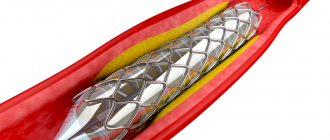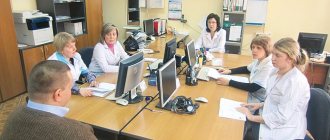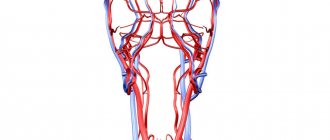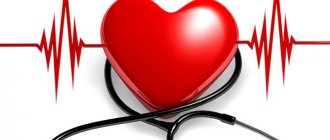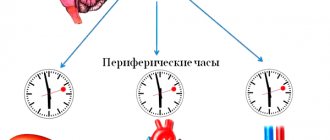CLASSIFICATION of cardiac arrhythmias
(V.L. Doshchitsin, 1991).
I. Impairment of impulse formation.
1. Sinus tachycardia. 2. Sinus bradycardia. 3. Sinus arrhythmia. 4. Migration of the rhythm source. 5. Extrasystole: a) suprapentricular and ventricular; b) single, group, allorhythmic. 6. Paroxysmal tachycardia: a) supraventricular and ventricular; b) paroxysmal and constantly recurrent. 7. Non-paroxysmal tachycardia and accelerated ectopic rhythms - supraventricular and ventricular. 8. Atrial flutter: a) paroxysmal and persistent; b) regular and irregular shapes. 9. Atrial fibrillation: a) paroxysmal and persistent; b) tachysystolic and bradysystolic forms. 10. Flickering (fibrillation) and ventricular flutter.
II. Conduction disorders.
1. Sinoatrial blockade—complete and incomplete. 2. Intraatrial block - complete and incomplete. 3. Atrioventricular block: a) I, II and III degrees; b) proximal and distal. 4. Intraventricular block: a) mono-, bi- and tri-fascicular, focal, arborptic; b) complete and incomplete.
III. Combined arrhythmias.
1. Sick sinus syndrome. 2. Escaping (slipping) contractions and rhythms - supraventricular and ventricular. 3. Syndromes of premature excitation of the ventricles. 4. Parasystoles. 5. Long QT syndrome.
Classification of ventricular extrasystole
(Lown, 1983).
1 tbsp. - single, rare monotonous extra-tables, no more than 60 per 1 hour (no more than 1 per 1 minute). Stage 2—frequent—monotopic extrasystoles, more than 1 per minute. 3st. - polytopic, frequent ventricular extrasystoles. 4st. - group ventricular extrasystoles (double and volley). 5th stage - early extrasystoles, type “R” to “T” and extra early.
3-5 tbsp. - these are extrasystoles of high gradation, indicate myocardial damage, are prognostically unfavorable (can develop into more serious rhythm disturbances).
With ischemic heart disease, almost all of the listed cardiac arrhythmias are possible, usually in combination with other manifestations of the disease: angina pectoris, myocardial infarction, heart failure. Thus, in the acute period of myocardial infarction, rhythm disturbances are recorded in almost all patients. 60-80% of patients with coronary artery disease die suddenly due to ventricular fibrillation (E. Chazov, 1985; Lown, 1983).
Temporary disability
The approximate periods of temporary disability for this disease are as follows:
- for first-time exertional angina – from 10 to 12 days.
With increasing duration or frequency of attacks (without changing the functional class):
- II FC – from 10 to 15 days;
- III FC – from 20 to 30 days;
- IV FC – from 90 to 110 days;
- variant or progressive course of the disease - from 25 to 30 days.
Possible development of disability due to angina pectoris
Diagnostic methods
1. ECG at rest and during dosed physical activity (VEM).
2. Daily (Holter) monitoring. Indications:
— patient complaints of heart rhythm disturbances not documented by ECG; — identification of asymptomatic arrhythmias in individuals at high risk of their occurrence (hypertrophic cardomnopathy, aortic stenosis, etc.); — examination of the working capacity of persons engaged in professions related to the performance of work, the sudden cessation of which could harm others (pilot, dispatcher, driver, etc.); - syncope of unknown origin.
3. EPI - transesophageal. 4. Endocardial EPI and programmed electrical stimulation of the heart.
Indications:
- repeated episodes of ventricular fibrillation; - severe attacks of ventricular tachycardia; - frequent and severe attacks of supraventricular tachycardia; - syncope of presumably arrhythmic origin; — indications for surgical treatment of arrhythmias; — selection of drug antiarrhythmic therapy.
Contraindications
If the patient has been assigned a disability due to coronary artery disease or angina pectoris FC 2-3, there are contraindications to the following types of work:
- maintenance of electromechanical installations;
- performing any type of work at high altitude;
- working with toxic substances;
- work that requires significant physical exertion.
IHD and exertional angina FC 2-3, regardless of what disability group was assigned by the ITU commission, does not allow activities, the cessation of which poses a danger to the lives of other people. This can happen during a heart attack.
TREATMENT
Drug treatment
.
Classification of antiarrhythmic drugs:
Group I (membrane stabilizing agents) A: quinidine, novocainamide, etc.; B: Lidocaine, diphenylhydantoin; C: ajmaline, ethmoznn, etacizin, allapinin. Group II (beta-blockers). Group III (drugs that slow down repolarization): amiodarone, bretylium tosylate. Group IV (calcium antagonists): verapamil, nifedipine.
Any antiarrhythmic drug can cause both antiarrhythmic and arrhythmogenic effects. The probability of an antiarrhythmic effect for most drugs is on average 50% and very rarely, only in a few clinical forms of arrhythmias, reaches 90-100%: a) relief of reciprocal atrioventricular tachycardia using intravenous administration of ATP, adenosine or verapamil; b) relief and prevention of paroxysmal tachycardia with complexes such as right bundle branch block and sharp deviations of the heart axis to the left with the help of verapamil; c) elimination of ventricular extrasystole with etacizine, flecainide.
In all other cases, the selection of antiarrhythmic therapy will be done by trial and error. In this case, the probability of an arrhythmogenic effect is on average 10%, in some cases life-threatening for the patient. The more severe the rhythm disturbances and the degree of myocardial damage, the higher the risk of an arrhythmogenic effect. Therefore, at present, most researchers believe that for asymptomatic and low-symptomatic arrhythmias, as a rule, the prescription of antiarrhythmic drugs is not required (A. S. Smetnen et al., 1993).
If drug therapy is necessary, the selection of antiarrhythmic drugs is based on the nature of the rhythm disturbance.
Supraventricular rhythm disturbances
1. Acute (extrasystole, paroxysmal atrial fibrillation, atrial flutter): procainamide, quinidine; (paroxysmal tachycardia): physical methods, isoptin, ATP, beta-blockers. 2. Prevention of paroxysms: cordarone, quinidine, beta-blockers.
Ventricular arrhythmias
1. Acute (extrasystole, paroxysmal tachycardia, fibrillation): lidocaine, nonocainamnd, etacizium, cordarone. 2. Prevention of paroxysms: cordarone, quinidine, diphenylhydantoin, novocainamide.
Special forms of rhythm disturbance:
1. WPW syndrome: cordarone, ethmozin, gilurythmal (ajmalin). Contraindicated: cardiac glycosides and partially isoptic. 2. Sick sinus syndrome: rhythmylene, quinidine (under control of sinus node activity).
Non-drug treatments
1. Electrical defibrillation. 2. Electrical stimulation of the heart.
Surgery
1. Intersection of additional pathways. 2. Removal, destruction or isolation of arrhythmogenic foci in the heart. 3. Cardiac stimulation (permanent, temporary). 4. Destruction of the atrioventricular node with implantation of a pacemaker.
Is disability allowed after a heart attack and stenting?
Myocardial infarction is a severe condition that is accompanied by ischemia and necrosis of a certain part of its muscle. This pathology is irreversible - dead cells will not be able to recover or grow again. It requires a long period of treatment and rehabilitation, which does not always lead to the restoration of normal organ function. Therefore, patients are entitled to disability (permanent or temporary). Also, patients often need to change professions, especially if their activities are associated with hazardous work.
Stenting is a minimally invasive operation performed with a special catheter, during which a section of the coronary artery is widened to improve blood supply to the myocardium.
Although this surgical intervention does not open the chest and subsequently does not require much time for rehabilitation, nevertheless, it may result in disability. This happens not due to the fact of the operation, but rather taking into account the disease that required the intervention.
Decision criteria: what determines the verdict
I draw your attention to the fact that absolutely all patients who have suffered a major heart attack have the right to four months of paid rehabilitation according to the certificate of incapacity for work. Only after this period has passed can you think about how to obtain a disability group.
Based on experience, I can say that about 40-50% of patients recover quite well over the elapsed period of treatment and can begin their professional duties if their work does not involve increased physical activity, but we will talk about this later. The rest of the patients, on the recommendation of the attending physician, can undergo examination by a medical and social expert commission to establish the fact of loss of ability to work.
This body evaluates the subject according to the following parameters:
- the possibility of self-service at home;
- ability to return to previous profession;
- patient education;
- general health indicators that will allow you to judge the degree of recovery after a pathology.
Taking into account the above, disability for myocardial infarction is given to persons who:
- performed work accompanied by frequent stress and requiring increased attention or excessive physical activity;
- have reached retirement age;
- have undergone surgical interventions on the coronary vessels (bypass surgery, stenting, etc.);
- have consequences of the disease (heart failure, unstable angina);
- have lost their ability to work by 50% or more;
- underwent rehabilitation for over 4 months.
It is necessary to understand that even if you are included in one of the categories, this does not guarantee that you will be assigned a disability group. Each case is considered individually by the commission and a large number of different factors are taken into account (comorbidities, complications).
Which group and in what case is it given?
In total, there are three groups of disability, one or another is formed not as a result of a heart attack, but against the background of complications that developed after it. The inspection procedure at MSEC is fixed by Government Decree No. 95 (dated February 20, 2006) .
The table lists the groups and examples of reasons for obtaining them.
| Third group | Assigned for 1-3 years if cardiac functions are slightly impaired and the patient, after treatment and rehabilitation, can begin his work duties. |
| Second group | Such a verdict is made in the case of consequences of a heart attack (malignant arrhythmia), when the patient’s recovery is poor and he will not be able to return to his previous place of work, but will be forced to change it. |
| First group | It is received by patients who are unable to care for themselves. They constantly experience pain, suffer from angina attacks, etc. |
ITU UNDER NDS IS DETERMINED BY THE FOLLOWING MAIN FACTORS
a) the severity of rhythm disturbances; b) the nature of the disease that caused the rhythm disturbances; c) the presence of contraindicated working conditions; d) the nature of the treatment (medicinal, surgical).
Severity of heart rhythm disturbances
The severity of heart rhythm disturbances is determined by: a) the frequency of their occurrence (paroxysmal form);
b) duration (paroxysmal form); c) hemodynamic state; d) actual and probable complications: heart failure (acute and chronic); acute coronary insufficiency or progressive chronic; acute cerebrovascular insufficiency or progressive chronic; thromboembolic complications; syncope or sudden death. In terms of assessing work capacity, it is inappropriate to separate different forms of NSR and conductivity according to their severity and prognostic significance.
1. Mild degree
(insignificant NSR and conductivity): supraventricular and ventricular extrasystoles (I-II gradations according to Lown); brady- or normosystolic constant form of atrial fibrillation; sick sinus syndrome with a rhythm frequency of more than 50 per minute; paroxysms of atrial fibrillation and supraventricular tachycardia, occurring once a month or less, lasting no more than 4 hours and not accompanied by subjectively perceived changes in hemodynamics; A-B blockade of the 1st degree and 2nd degree (Mobitz type I); mono- and bifascicular blockades of the branches of the His bundle.
2. Moderate severity.
Polytopic frequent (1: 10) ventricular extrasystole (III gradation according to Laun); paroxysms of atrial fibrillation, atrial flutter; supraventricular tachycardia, occurring 2-4 times a month, lasting more than 4 hours, accompanied by changes in hemodynamics felt by patients; conduction disorders: A-B Mobitz block II and III degrees, tri-fascicular block of the branches of the His bundle, sick sinus syndrome, sinoauricular block III degree, junctional rhythm with a heart rate of more than 40 per minute and the absence of HF.
3. Severe degree.
Ventricular extrasystole - frequent polytopic, volley, early (IV-V gradation according to Laun);
paroxysms of atrial fibrillation, atrial flutter, supraventricular tachycardia, occurring several times a week, accompanied by pronounced changes in hemodynamics, difficult to tolerate by patients; paroxysms of ventricular tachycardia; a permanent form of atrial fibrillation, tachysystolic atrial flutter, not corrected by medications and accompanied by progressive heart failure; sick sinus syndrome, trifascicular His bundle block, Frederick's syndrome with heart rate less than 40 per minute, attacks of MES and syncope, progressive heart failure. Functionally significant deterioration of hemodynamics as a result of rhythm and conduction disturbances, the emergence or increase in the severity of heart failure is determined not only by the form of NSR, but also by the initial state of the myocardium (cardiosclerosis) and coronary and cerebral arteries (atherosclerosis).
Thromboembolic complications, syncope and sudden death can occur when NSR and conduction are the only manifestation of the disease: congenital anomalies of the cardiac conduction system; isolated damage to the artery supplying the sinus node, isolated focal cardiosclerosis involving the conduction system of the heart, non-progressive hypertrophic cardiomyopathy.
Procedure for conducting the examination
The survey is carried out by specialists who are members of the bureau. In addition, the commission may include representatives of the employment service and other extra-budgetary funds.
The examination includes an examination of the patient’s condition, analysis of the attached documentation, clarification of the patient’s living conditions and other information. The decision is made by the members of the commission during voting. In this case, an ITU act is drawn up.
Survey
As a rule, in case of vascular and heart diseases, disability is given for a period of 12 months. Therefore, patients should undergo regular examination. Sometimes a person may be denied extension of disability. If the patient does not agree with the decision of the commission, he can appeal this decision within 30 days to the ITU bureau. To resolve particularly controversial issues, you can turn to the courts.
Contraindicated working conditions
1. Working conditions contraindicated in case of the underlying disease that caused NSR and conductivity (IHD, rheumatism, and others).
2. The presence or risk of ventricular arrhythmias and asystole: work that poses a danger to others and the patient in the event of its sudden cessation (driver, pilot, railway and aeroflot dispatcher, work at height and in extreme conditions). In most cases of NSD, the ability of patients to work is determined by the underlying disease that was their cause. Difficulties in MSE, as a rule, arise more often when the only manifestation of the pathological process is a violation of rhythm and conduction.
Able-bodied
1. Insignificant (mild) rhythm disturbances.
2. Average severity of rhythm disturbances with the exception of contraindicated labor factors. Reduced ability to work (limited ability to work - disability group III): 1. Severe degree of rhythm disturbance. Heart rhythm and conduction disturbances, as a rule, do not have independent significance in permanent disability and are considered in combination with the underlying disease that caused their occurrence. It should be taken into account that NSR and severe conduction may contribute to the progression of heart failure and indicate a high risk of sudden death.
The greatest difficulties arise when it is necessary to assess the ability to work and rationally employ patients with continuous electrical cardiac stimulation (PECS).
This method is currently widely used for the treatment of the following NSR and conduction: acquired complete A-B block in the presence of MES attacks and a heart rate of less than 40 beats per minute; congenital permanent A-B block with a heart rate less than 50 beats per minute; A-B blockade of the second degree (Mobitz II); blockade of both bundle branches; sick sinus syndrome, tachybradcardia syndrome; supraventricular paroxysmal tachycardia and atrial fibrillation, resistant to drug therapy; WPW syndrome.
Recommendations
In certain cases, patients with angina pectoris, based on an examination by medical and social experts, are assigned a disability group, but the patient can keep his job if the necessary conditions are met:
- if the patient has angina pectoris FC 2, he is entitled to 3 disability, as well as the first degree of restriction of work activity with further placement in a suitable workplace or complete retraining in accordance with the adopted rehabilitation program;
- but at the same time, disability due to angina pectoris 2 FC with positive prognosis implies the ability to maintain the same job and engage in simple mental or physical labor;
- If angina pectoris of FC 3 develops with ischemic heart disease, the patient is assigned a group 2 disability, simple work activity in special conditions is possible, a favorable microclimate is necessary.
With a pathology such as angina pectoris, disability is given depending on the severity of the dysfunction of the body and the impact of these changes on the patient’s ability to perform certain types of work. The disability group is assigned in accordance with certain criteria according to which the patient's condition is assessed.
Indications for referral to MSE for patients with implanted pacemakers
To extend the duration of VUT in cases of effective pacemaker implantation and a favorable clinical and labor prognosis with: - the presence of complications in the postoperative period (pleurisy, pericarditis, etc.);
- heart rhythm disturbances of moderate severity (for example, ventricular extrasystole more than 6-8 per minute, parasystole, etc.), requiring active and long-term drug therapy; — presence of signs of the initial stage of heart failure; disorders of psychological adaptation to ECS requiring psychotherapeutic correction. 2. To determine the disability group for persons of working age: - the presence of absolute medical contraindications to the continuation of the previous professional activity and the need, in connection with this, to transfer to another job with a reduction in volume, qualifications or a change in profession; — ineffectiveness of PEX, as a result of which attacks of NSR and conduction persist, which is accompanied by significant dysfunction of the cardiovascular system; — presence of complications of PEX requiring long-term treatment; - absolute dependence of the patient on PEX; - worsening of the underlying disease.
3. Re-examination of disabled people with PEX.
The required minimum of research when referring a patient for medical examination.
The required amount of research is determined by the underlying disease and includes: a) the results of a study of the degree of dependence of the patient on the pacemaker; b) ECG at rest; VEM test (threshold power - 75 W); c) daily monitoring (according to indications); d) integral rheography or echocardiography; e) chest x-ray; f) consultation with a psychotherapist.
Contraindicated working conditions (absolute):
1. Work associated with being in conditions of strong static charges, magnetic fields and pronounced effects of microwave fields.
2. Work related to electrolytes and under conditions of exposure to strong induction of thermal and light radiation from stoves and radiators. 3. Work related to the maintenance of existing powerful electrical installations. 4. Work in conditions of severe vibration. 5. Work associated with constant or episodic significant physical stress throughout the entire working day, at a prescribed pace, and in a forced body position. 6. Work associated with potential danger to others due to its sudden cessation by patients. Patients should be considered able to work if they are effectively treated with a permanent pacemaker: the disappearance of previously existing PSR and conductivity, significant or complete regression of HF phenomena, and the absence of complications in the postoperative period. As a result, in such patients, after 1.5-2 months, the quality of life improves, a normal psychological reaction is established, the required level of physical activity is achieved, and they can resume their professional activities in professions of mental or light physical labor.
A necessary condition for the restoration of working capacity is the patient’s independence from the pacemaker: the emergence of his own heart rhythm after suppression of the pacemaker.
What groups are assigned?
Disability is granted based on the following signs that characterize the patient’s health status:
- injury and damage to the circulatory system, which entails difficulty in performing basic everyday activities;
- congenital anomalies of the structure of the heart, leading to difficulties in performing work activities;
- loss of independent movement of the patient;
- presence of need for rehabilitation measures and specialized care.
The following groups are distinguished for heart diseases. The first group is given if the patient needs constant care from third parties. The second group is assigned when a person has partially lost physical abilities, with moderate heart disease. Patients, provided favorable conditions are created, can take care of themselves. The third group is given if patients can take care of themselves, but they have some restrictions on their usual work activities.
Disability criteria
III group:
after the operation, there is an improvement in the general condition of the patients, but they have: a) a positive VEM test;
b) moderate disorders of the circulatory system; c) the presence of a persistent psychopathological reaction to pacemaker implantation with personality changes; d) the need for employment in non-contraindicated working conditions, with a decrease in the volume of production activities, qualifications or a change in profession. Group II:
ineffectiveness of surgical treatment using the PEX method:
a) previous NSR and conductivity are preserved; b) interference of ECS and own rhythms; c) pronounced manifestations of coronary and heart failure (angina pectoris class III—IV, heart failure stage IIB—III); d) absolute dependence on the ECS.
What diseases give disability?
Assignment of disability occurs when there is a persistent impairment of health, which causes disruption of the functioning of internal organs. The list of heart diseases eligible for the group includes:
- severe congenital heart disease (congenital heart disease), extreme circulatory disorder;
- myocardial infarction, causing insufficient blood supply to tissues and organs, provoking a functional cardiac disorder, necrosis of the myocardial muscle. Which leads to the physical inability of patients to perform work activities. Usually the disease progresses against the background of coronary heart disease and smoking;
- third stage hypertension, accompanied by frequent crises, increased blood pressure (blood pressure), which negatively affects the blood supply to brain tissue and causes paralysis.
Disability is also due after complex heart surgery. That is, if the patient has undergone valve replacement, bypass surgery, or vascular stenting. A more detailed list of diseases can be obtained from your attending physician.

